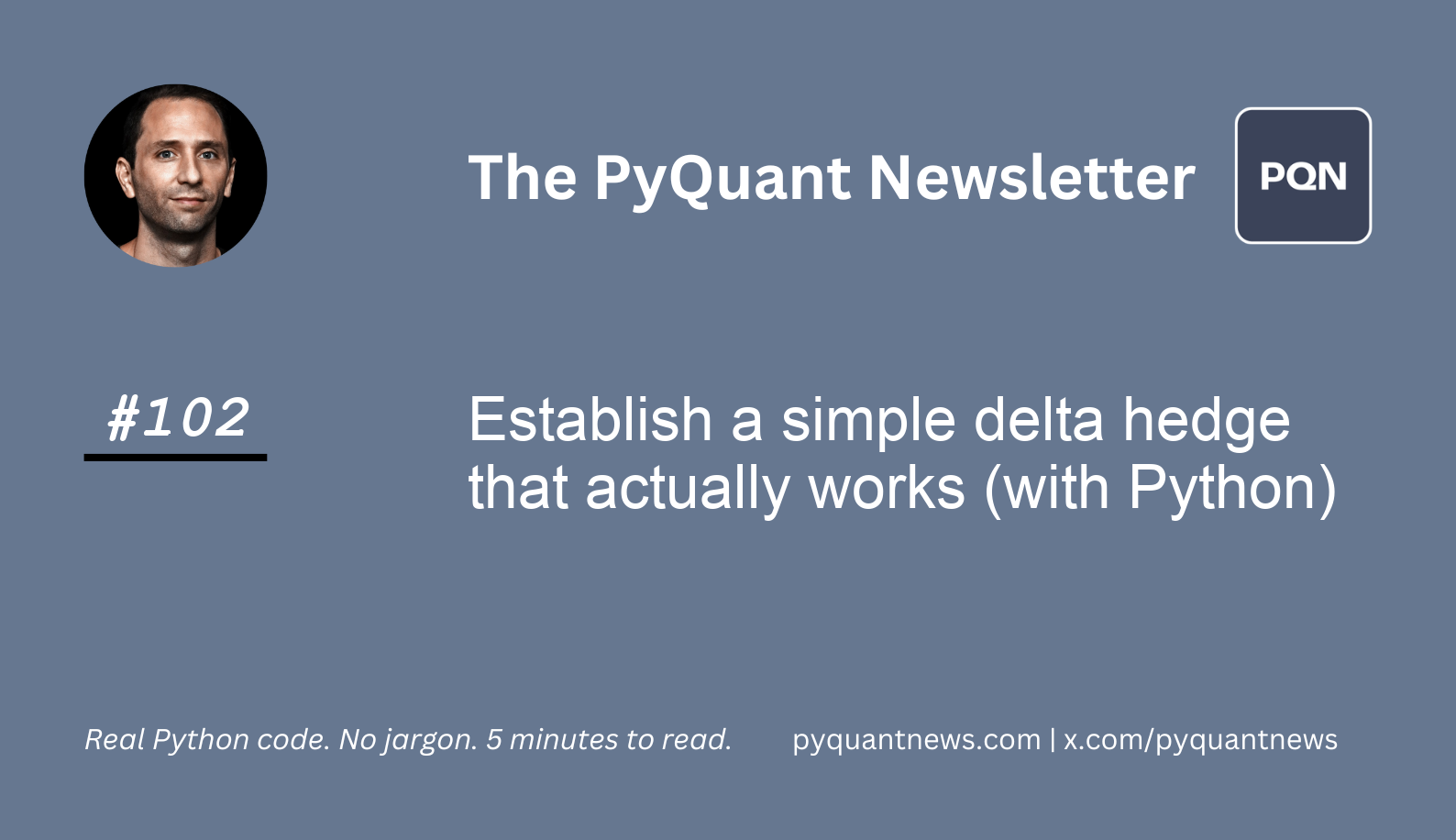Establish a simple delta hedge that actually works (with Python)






Establish a simple delta hedge that actually works (with Python)
Something beginner options traders always forget:
Hedging.
Without an effective hedging strategy, traders can face significant losses if the market moves against them.
Unfortunately, most people overcomplicate the process.
Delta hedging allows traders to offset price movements by adjusting positions in the underlying stock.
Most of my experience as a quant dealt with helping traders hedge their options positions. One the most common and effective methods we used was delta hedging.
By reading today’s newsletter, you’ll be able to use Python to build a simple delta hedge.
Let’s go!
Establish a simple delta hedge that actually works (with Python)
Delta hedging is a technique used in options trading to manage risk by offsetting price movements in the underlying asset. It involves adjusting the position in the underlying stock to neutralize the impact of these price changes.
In practice, delta hedging starts with calculating the delta of an options position. Delta, as you may know, measures an option’s sensitivity to the underlying asset's price changes.
Traders then adjust their stock position to be “delta-neutral,” where gains and losses from the stock and the option balance each other out.
Continuous monitoring and frequent rebalancing are required to maintain this neutral position as market conditions change.
Professionals use delta hedging to reduce directional risk and concentrate returns. They usually rely on trading platforms to calculate delta and make necessary adjustments.
However we can build a simple hedging strategy with Python
Import QuantLib and Set Up the Environment
Let's start by importing the necessary libraries and setting up the environment. We'll use QuantLib for financial modeling.
1import QuantLib as ql
2
3
4# Set the evaluation date
5today = ql.Date(15, 1, 2023)
6ql.Settings.instance().evaluationDate = today
7
8# Define the option parameters
9expiry = ql.Date(15, 7, 2023)
10strike_price = 100
11option_type = ql.Option.Call
12
13# Create the option
14payoff = ql.PlainVanillaPayoff(option_type, strike_price)
15exercise = ql.EuropeanExercise(expiry)
16european_option = ql.VanillaOption(payoff, exercise)We start by importing QuantLib and setting the evaluation date. Then, we define the expiry date, the strike price, and the type of option (a call option in this case). We create the option's payoff structure and its exercise style, and finally, we combine these to create a European option.
Use QuantLib to Price Our Option
Next, we will define the market parameters and use QuantLib to price the option.
1# Define the market parameters
2spot_price = 100
3volatility = 0.2 # 20%
4dividend_rate = 0.01 # 1%
5risk_free_rate = 0.05 # 5%
6
7# Create the market conditions
8spot_handle = ql.QuoteHandle(ql.SimpleQuote(spot_price))
9volatility_handle = ql.BlackVolTermStructureHandle(
10 ql.BlackConstantVol(today, ql.NullCalendar(), ql.QuoteHandle(ql.SimpleQuote(volatility)), ql.Actual365Fixed()))
11dividend_handle = ql.YieldTermStructureHandle(
12 ql.FlatForward(today, ql.QuoteHandle(ql.SimpleQuote(dividend_rate)), ql.Actual365Fixed()))
13risk_free_handle = ql.YieldTermStructureHandle(
14 ql.FlatForward(today, ql.QuoteHandle(ql.SimpleQuote(risk_free_rate)), ql.Actual365Fixed()))
15
16# Create the Black-Scholes-Merton process
17bsm_process = ql.BlackScholesMertonProcess(spot_handle, dividend_handle, risk_free_handle, volatility_handle)
18
19# Price the option using the analytic European engine
20european_option.setPricingEngine(ql.AnalyticEuropeanEngine(bsm_process))
21option_price = european_option.NPV()
22print(f"Option Price: {option_price:.2f}")We define the spot price, volatility, dividend rate, and risk-free rate, which are necessary for pricing the option. We then create “handles” to represent the market conditions for these parameters. Using these handles, we define the Black-Scholes-Merton process, set the pricing engine to use the analytic European engine for our option, and calculate the net present value (NPV) of the option
These steps give us the option price.
Calculate the Option Delta
Now, we calculate the delta of the option, which measures the sensitivity of the option's price to changes in the price of the underlying asset.
1# Calculate the option delta
2delta = european_option.delta()
3print(f"Option Delta: {delta:.2f}")We calculate the delta of the option using the pre-defined method in QuantLib. By calling the delta method on the option, we can get Delta. Delta tells us how much of the underlying asset we need to hold to hedge against price movements.
Implement Delta Hedging Strategy
Finally, let's implement a simple delta hedging strategy by adjusting the position in the underlying asset based on the calculated delta.
1# Initial stock position based on delta
2stock_position = delta * spot_price
3print(f"Initial Stock Position: {stock_position:.2f}")
4
5# Simulate a change in the spot price
6new_spot_price = 105
7spot_handle = ql.QuoteHandle(ql.SimpleQuote(new_spot_price))
8
9# Recalculate the option price and delta
10new_option_price = european_option.NPV()
11new_delta = european_option.delta()
12print(f"New Option Price: {new_option_price:.2f}")
13print(f"New Option Delta: {new_delta:.2f}")
14
15# Adjust the stock position for delta hedging
16new_stock_position = new_delta * new_spot_price
17hedge_adjustment = new_stock_position - stock_position
18print(f"Adjustment in Stock Position: {hedge_adjustment:.2f}")We calculate the initial stock position required to hedge the option by multiplying the delta by the spot price. This gives us the value of the stock position needed to offset changes in the option's price. We then simulate a change in the spot price and update the spot handle with the new value.
By recalculating the option's price and delta with the new spot price, we determine the new stock position required. The difference between the new and initial stock positions gives us the adjustment needed to maintain the delta hedge.
Your next steps
Try changing the parameters of the option, such as the strike price or expiry date, and observe how the option price and delta change. You could also experiment with different market conditions, like varying the volatility or risk-free rate, to see their impact on the hedging strategy.
